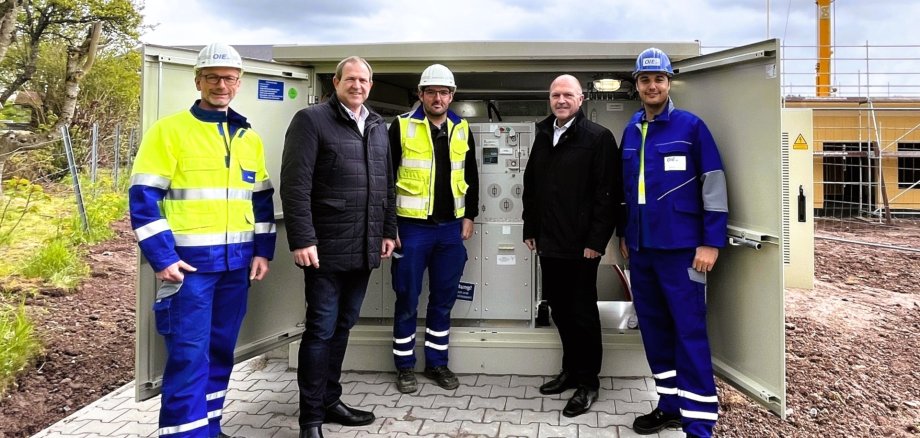The energy transition is making electricity distribution more complex. The transformation from a traditional electricity grid to the grid of the future ("smart city") is in full swing in Idar-Oberstein. In order to better monitor the electricity grids and control energy flows, the grids need to become more intelligent. The OIE is investing in the electricity grid of the future. In Regulshausen, the distribution grid operator Westnetz is connecting a digital local grid station to the grid on behalf of the company. This is located near the future kindergarten and will also supply it with electricity, from where the new development area in Regulshausen will also be connected. By digitizing the technology, the company will be able to better monitor and control the live data on electricity and voltage obtained from the grid in future and react more flexibly to changes in grid activities. Those responsible at OIE and the distribution grid operator Westnetz have now met with Idar-Oberstein's city leaders on site.
"Digital local network stations are proving to be extremely advantageous, especially at crucial switching points. Remote access often allows us to intervene quickly in the event of faults and restore supplies to residents more quickly. In addition, the improved grid monitoring enables an up-to-date analysis of the power flow and consumption," explains Jan Knebel, grid planner at Westnetz. Local grid stations convert medium voltage into standard household low voltage. Digital local grid stations have the same function, but also transmit live data via mobile radio or fiber optics. This allows the electricity grid to be analyzed and controlled in real time. The data helps the distribution grid operator to expand the grid in line with demand. In addition, the system detects unwanted incidents such as power outages particularly quickly: the technology helps to isolate faults in the grid and shortens downtimes in the power grid thanks to the option of remote control.
"Within a few years, our grids will be under greater strain due to the expansion of electromobility, heat pumps and the increasing feed-in of energy from decentralized sources such as photovoltaic systems. In order to meet these requirements, we are already equipping our technology for the future. Twelve digital local grid stations have already been installed in Idar-Oberstein, with a further five to follow this year. This makes us a pioneer in Idar-Oberstein. However, this is only possible thanks to the backing of the town council and the town board, which is why we would like to express our special thanks to all of them," says OIE board member Thomas Johann. Frühauf and Marx are also convinced that digitalization is the engine of progress for the city of Idar-Oberstein. "This investment in the future of our energy infrastructure will strengthen security of supply and at the same time lay the foundations for further regional growth and progress," they both agree. The city board and the city council attach great importance to this progressive development and are thus setting an example for the entire region.
OIE and its distribution grid operator Westnetz are making significant investments to expand and strengthen the electricity grid over the next few years. The measures include all levels of the distribution grid, such as the expansion of substations, but also the construction of digital local grid stations. This will make it possible to precisely control the grids in the event of unexpected consumption peaks or high electricity yields from decentralized power generation, such as photovoltaic or wind power plants. As a driver of the energy transition, the OIE is thus playing a leading role in the necessary restructuring of the energy grids in the region.
Background:
The electricity grid can be thought of as a road network: There are highways, federal highways and country roads. The electricity grid is also divided into the high-voltage grid (110,000 volts), the medium-voltage grid (10,000 volts) and the low-voltage grid (400 volts). The different grids serve different customers: the high-voltage grid serves larger towns and energy-intensive companies, the medium-voltage grid serves smaller towns and companies and the low-voltage grid serves individual households and businesses. Substations and local grid stations provide the connection between the individual voltage levels - comparable to highway interchanges or highway exits.
